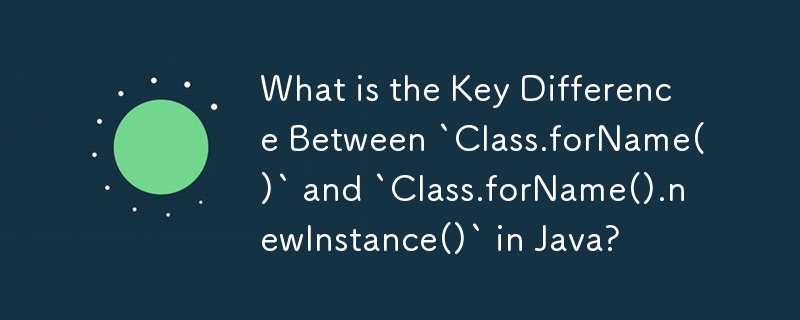 Java
Java
 javaTutorial
javaTutorial
 What is the Key Difference Between `Class.forName()` and `Class.forName().newInstance()` in Java?
What is the Key Difference Between `Class.forName()` and `Class.forName().newInstance()` in Java?
What is the Key Difference Between `Class.forName()` and `Class.forName().newInstance()` in Java?

Understanding the Distinction Between "Class.forName()" and "Class.forName().newInstance()"
In Java, both Class.forName() and Class.forName().newInstance() play crucial roles in dynamic class loading. However, they serve distinct purposes.
Class.forName()
The Class.forName() method takes a fully qualified class name as a string and returns the Class object associated with that class. It does this by using the class loader to locate the class file and read its contents. Class.forName() does not instantiate the class. It simply provides access to its metadata and information.
Class.forName().newInstance()
The Class.forName().newInstance() method, on the other hand, creates a new instance of the class represented by the Class object returned by Class.forName(). It does this by invoking the class's default constructor.
Example:
Let's consider an example to illustrate the difference:
package test;
public class Demo {
public Demo() {
System.out.println("Hi!");
}
public static void main(String[] args) throws Exception {
Class clazz = Class.forName("test.Demo");
Demo demo = (Demo) clazz.newInstance();
}
}In this example:
- Class clazz = Class.forName("test.Demo"): This line loads the Demo class using Class.forName(). clazz now holds the Class object for the Demo class.
- Demo demo = (Demo) clazz.newInstance(): This line creates a new instance of the Demo class using Class.forName().newInstance(). The (Demo) cast is necessary because clazz.newInstance() returns an Object.
Key Difference:
The key difference between Class.forName() and Class.forName().newInstance() is that Class.forName() only loads the class, while Class.forName().newInstance() not only loads the class but also creates an instance of that class.
Dynamic Class Loading Use Cases:
Class.forName() and Class.forName().newInstance() are commonly used in scenarios where dynamic class loading is required. Examples include:
- JDBC drivers loading at runtime based on database requirements.
- EJB and Servlet containers dynamically loading and creating components.
- Plugins or extensions that are loaded on demand.
The above is the detailed content of What is the Key Difference Between `Class.forName()` and `Class.forName().newInstance()` in Java?. For more information, please follow other related articles on the PHP Chinese website!

Hot AI Tools

Undresser.AI Undress
AI-powered app for creating realistic nude photos

AI Clothes Remover
Online AI tool for removing clothes from photos.

Undress AI Tool
Undress images for free

Clothoff.io
AI clothes remover

Video Face Swap
Swap faces in any video effortlessly with our completely free AI face swap tool!

Hot Article

Hot Tools

Notepad++7.3.1
Easy-to-use and free code editor

SublimeText3 Chinese version
Chinese version, very easy to use

Zend Studio 13.0.1
Powerful PHP integrated development environment

Dreamweaver CS6
Visual web development tools

SublimeText3 Mac version
God-level code editing software (SublimeText3)

Hot Topics
 Is the company's security software causing the application to fail to run? How to troubleshoot and solve it?
Apr 19, 2025 pm 04:51 PM
Is the company's security software causing the application to fail to run? How to troubleshoot and solve it?
Apr 19, 2025 pm 04:51 PM
Troubleshooting and solutions to the company's security software that causes some applications to not function properly. Many companies will deploy security software in order to ensure internal network security. ...
 How to simplify field mapping issues in system docking using MapStruct?
Apr 19, 2025 pm 06:21 PM
How to simplify field mapping issues in system docking using MapStruct?
Apr 19, 2025 pm 06:21 PM
Field mapping processing in system docking often encounters a difficult problem when performing system docking: how to effectively map the interface fields of system A...
 How to elegantly obtain entity class variable names to build database query conditions?
Apr 19, 2025 pm 11:42 PM
How to elegantly obtain entity class variable names to build database query conditions?
Apr 19, 2025 pm 11:42 PM
When using MyBatis-Plus or other ORM frameworks for database operations, it is often necessary to construct query conditions based on the attribute name of the entity class. If you manually every time...
 How do I convert names to numbers to implement sorting and maintain consistency in groups?
Apr 19, 2025 pm 11:30 PM
How do I convert names to numbers to implement sorting and maintain consistency in groups?
Apr 19, 2025 pm 11:30 PM
Solutions to convert names to numbers to implement sorting In many application scenarios, users may need to sort in groups, especially in one...
 How does IntelliJ IDEA identify the port number of a Spring Boot project without outputting a log?
Apr 19, 2025 pm 11:45 PM
How does IntelliJ IDEA identify the port number of a Spring Boot project without outputting a log?
Apr 19, 2025 pm 11:45 PM
Start Spring using IntelliJIDEAUltimate version...
 E-commerce platform SKU and SPU database design: How to take into account both user-defined attributes and attributeless products?
Apr 19, 2025 pm 11:27 PM
E-commerce platform SKU and SPU database design: How to take into account both user-defined attributes and attributeless products?
Apr 19, 2025 pm 11:27 PM
Detailed explanation of the design of SKU and SPU tables on e-commerce platforms This article will discuss the database design issues of SKU and SPU in e-commerce platforms, especially how to deal with user-defined sales...
 How to safely convert Java objects to arrays?
Apr 19, 2025 pm 11:33 PM
How to safely convert Java objects to arrays?
Apr 19, 2025 pm 11:33 PM
Conversion of Java Objects and Arrays: In-depth discussion of the risks and correct methods of cast type conversion Many Java beginners will encounter the conversion of an object into an array...
 How to elegantly get entity class variable name building query conditions when using TKMyBatis for database query?
Apr 19, 2025 pm 09:51 PM
How to elegantly get entity class variable name building query conditions when using TKMyBatis for database query?
Apr 19, 2025 pm 09:51 PM
When using TKMyBatis for database queries, how to gracefully get entity class variable names to build query conditions is a common problem. This article will pin...





